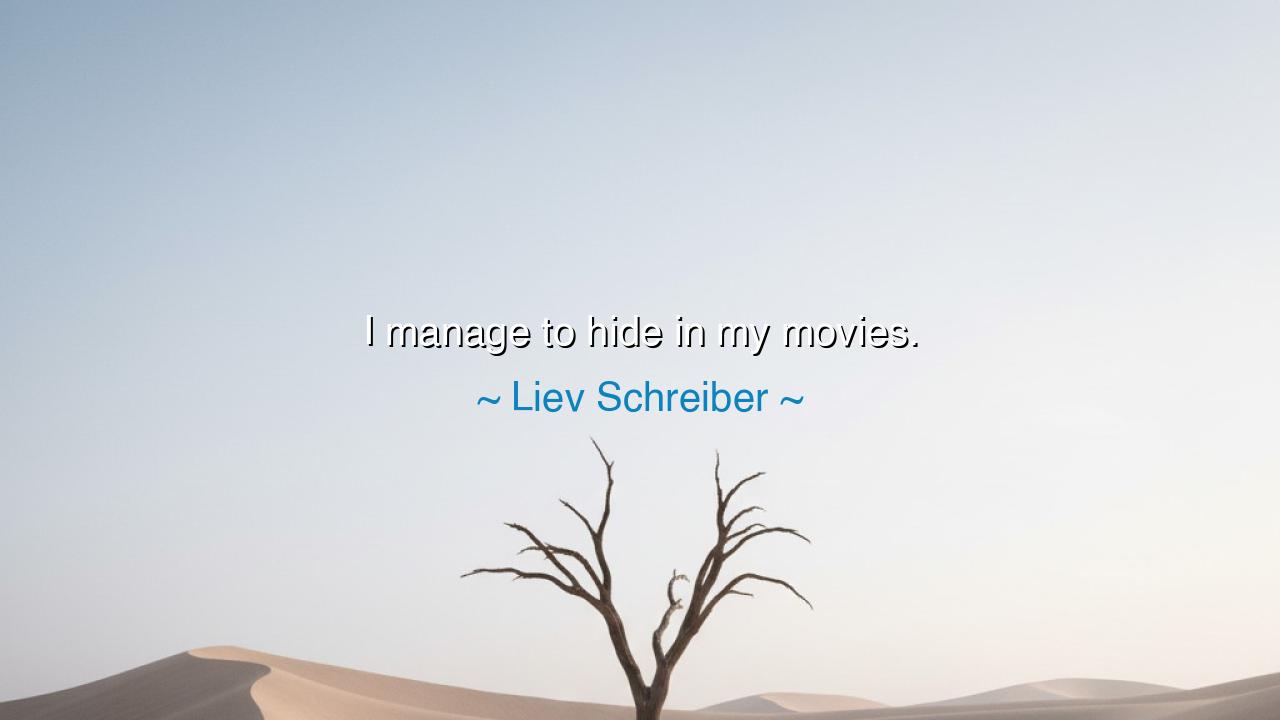
I manage to hide in my movies.






"I manage to hide in my movies." These words, spoken by the actor Liev Schreiber, reveal a deep truth about the nature of art and the role of the artist. In this simple statement, Schreiber speaks of the profound connection between the artist and their craft, the way in which one can hide behind the characters they portray, yet at the same time, reveal something of themselves in the process. To hide in the world of movies is not an act of evasion, but one of transformation—where the artist, through their performance, can explore the hidden recesses of the self and, paradoxically, find freedom in that very concealment.
O Seekers of Wisdom, consider this: art is a mirror. Through the craft of creation, the artist often seeks to hide what they fear, what they cannot speak of, what they wish to escape from. But in doing so, they end up revealing those very parts of themselves to the world. In the act of hiding, the artist exposes their soul, for the stories they tell and the characters they bring to life are never fully separate from their own inner world. Schreiber's words remind us that in the process of artistic expression, there is both a refuge and a revelation—a place to hide and yet, at the same time, a way to share what is most personal.
Think of William Shakespeare, whose own personal life remains shrouded in mystery, yet through his plays, he revealed the deepest complexities of the human spirit. From the jealous heart of Othello to the ambitious mind of Macbeth, Shakespeare used the stage to hide behind his characters and in doing so, exposed the greatest truths about human nature. Every line spoken by his characters is a glimpse into the human condition, a reflection of what he understood but could not always speak in his own life. Through the art of performance, Shakespeare found freedom in revealing what was most difficult to express.
Likewise, consider the life of Vincent van Gogh, who often spoke of his art as his refuge, a place where he could escape the turmoil of his own mind. His paintings, with their wild strokes and vivid colors, are not just images of the world—they are expressions of the intense struggles and emotions he kept hidden. Van Gogh did not merely paint the flowers, the stars, or the people around him—he painted his soul. And in doing so, he found a way to hide within his art, even as he revealed his deepest pain. His art became both a shield and a sword, a way to navigate his inner darkness while also sharing it with the world.
O Children of the Future, hear this truth: the act of creating is an act of transformation. In the process of hiding, the artist often finds their truest voice. In their works, they may disguise themselves, take on the face of another, and slip into the skin of a character, yet in doing so, they find freedom. For in the world of creation, there are no limits, no boundaries, and no judgment. It is here that the artist can reveal the deepest parts of themselves, cloaked in the form of something new. Through art, they hide, and through art, they reveal.
But let us be clear, O Seekers: to hide is not to run from life, but to engage with it in a different way. The artist’s freedom lies not in avoidance, but in their ability to transform their pain, their fears, their dreams, and their desires into something that speaks to the heart of others. The movies, the paintings, the stories they create are not mere distractions—they are ways of understanding the world and the self, ways of making sense of the chaos and beauty of existence. In hiding within their craft, the artist brings forth what is most real and most human.
Lesson: The wisdom of Liev Schreiber reminds us that in hiding, we can find the greatest freedom. Through art, we can transform our deepest struggles and emotions into something that connects us to the world. The act of hiding behind the characters or the canvas is not an escape, but a powerful way of revealing what lies beneath the surface. Practical action: In your own life, whether through art, work, or relationships, consider how you might hide in a way that reveals your truest self. Embrace the creative process as a means of self-discovery, and know that in doing so, you may reveal to others the deepest parts of your soul. Let your work be both your refuge and your voice, and in this, you will find freedom.






AAdministratorAdministrator
Welcome, honored guests. Please leave a comment, we will respond soon